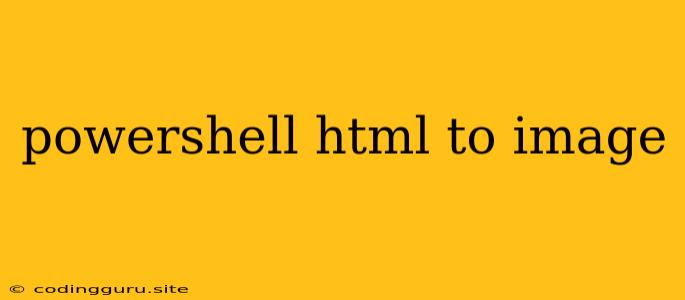Transforming HTML to Images with PowerShell: A Practical Guide
Converting HTML content into images is a common task, especially when you want to share web pages, create visual presentations, or embed content within other applications. PowerShell, a powerful scripting language for Windows, provides a flexible way to achieve this transformation. This guide will walk you through the process, highlighting essential techniques and best practices.
Understanding the Process
Before diving into code, let's outline the key steps involved in converting HTML to images using PowerShell.
- HTML Preparation: Ensure your HTML is well-formed and contains all necessary CSS styles for the desired image output.
- Choosing a Rendering Engine: The core of this conversion lies in using a tool that can interpret the HTML and render it visually.
- Image Export: Once rendered, you'll need to capture the visual output and save it as an image file.
PowerShell Techniques for HTML to Image Conversion
1. Utilizing the Internet Explorer COM Object
One straightforward approach is to leverage the Internet Explorer COM object within PowerShell. This method allows you to render the HTML in a browser-like environment and then capture a snapshot of the rendered content.
# Load the Internet Explorer COM object
$ie = New-Object -ComObject "InternetExplorer.Application"
# Navigate to the HTML content (can be a local file or URL)
$ie.Navigate("https://www.example.com")
# Wait for the page to load
while ($ie.ReadyState -ne 4) {
Start-Sleep -Milliseconds 100
}
# Capture the rendered content as a bitmap image
$ie.Document.body.CaptureAsBitmap().Save("output.bmp")
# Clean up
$ie.Quit()
Important Considerations:
- Internet Explorer Compatibility: This method relies on Internet Explorer, so make sure it's installed on your system.
- Dynamic Content: Be aware that if your HTML includes dynamic content (e.g., JavaScript), the rendering might not perfectly capture all interactive elements.
2. Leveraging WebKit (Chrome)
If you need to capture images with advanced CSS styling or JavaScript execution, consider using a more modern rendering engine like WebKit (the engine behind Google Chrome). You can achieve this using libraries like wkhtmltopdf:
Step 1: Installation
# Install wkhtmltopdf (requires a package manager like Chocolatey)
choco install wkhtmltopdf
Step 2: Conversion Script
# Define the HTML source (file or URL)
$htmlSource = "https://www.example.com"
# Define the image output file path
$outputFile = "output.png"
# Execute wkhtmltopdf to create a PNG from the HTML
wkhtmltoimage --format png --quality 100 "$htmlSource" "$outputFile"
Advantages:
- Enhanced Rendering: WebKit provides more accurate and comprehensive rendering for modern web pages.
- JavaScript Support: WebKit can handle dynamic content generated by JavaScript.
- Image Quality: wkhtmltopdf offers flexibility in controlling image quality.
Tips and Best Practices
- Optimize HTML for Rendering: Make sure your HTML is clean and well-structured to improve rendering accuracy.
- Use a Dedicated Tool: Employ specialized tools like wkhtmltopdf or WebKit-based libraries for more reliable and feature-rich image generation.
- Experiment with Options: Explore different image formats (PNG, JPEG, BMP), quality levels, and output options to find the best settings for your use case.
- Error Handling: Implement error handling in your scripts to catch potential issues during the rendering and image saving processes.
- Security Considerations: If you're dealing with sensitive information, be mindful of potential vulnerabilities when using third-party tools or rendering engines.
Common Challenges and Solutions
- Missing Styles: If the generated image is not styled correctly, ensure that all CSS stylesheets are properly linked or embedded in your HTML.
- Image Resolution: Use the appropriate quality and resolution settings (using options like
--qualityand--widthinwkhtmltopdf) to achieve the desired image size. - Rendering Errors: If you encounter errors during rendering, check for typos in your code, file paths, or HTML content.
Beyond Basic Conversion
- Customization: You can further customize the image generation by adding specific options to your
wkhtmltopdfcommand, such as setting page size, margins, headers, and footers. - Batch Processing: Use PowerShell loops and scripting techniques to automate the conversion of multiple HTML files.
- Integration: Integrate your PowerShell conversion script into other workflows or applications.
Conclusion
PowerShell provides a powerful toolkit for manipulating HTML content and generating images. By utilizing techniques like using the Internet Explorer COM object or employing tools like wkhtmltopdf, you can effectively convert HTML to images for a variety of applications. Remember to optimize your HTML, choose the right rendering engine, and handle any errors gracefully to achieve the best results.
